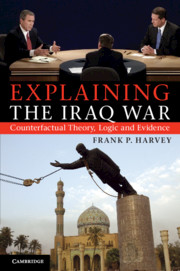Book contents
- Frontmatter
- Contents
- Figures
- Tables
- Acknowledgments
- Introduction
- 1 Comparative counterfactual analysis and the 2003 Iraq war
- 2 Leadership, political context(s) and the Iraq war
- 3 Democratic national security advisers
- 4 Domestic and congressional politics
- 5 American intelligence failures and miscalculations
- 6 Societal pressures and public opinion
- 7 International politics, global WMD consensus and UN power balancing
- 8 Hussein’s mistakes, miscalculations and misperceptions
- 9 Summary and implications
- 10 Conclusion
- Bibliography
- Index
2 - Leadership, political context(s) and the Iraq war
Published online by Cambridge University Press: 05 June 2012
- Frontmatter
- Contents
- Figures
- Tables
- Acknowledgments
- Introduction
- 1 Comparative counterfactual analysis and the 2003 Iraq war
- 2 Leadership, political context(s) and the Iraq war
- 3 Democratic national security advisers
- 4 Domestic and congressional politics
- 5 American intelligence failures and miscalculations
- 6 Societal pressures and public opinion
- 7 International politics, global WMD consensus and UN power balancing
- 8 Hussein’s mistakes, miscalculations and misperceptions
- 9 Summary and implications
- 10 Conclusion
- Bibliography
- Index
Summary
The Bush-neocon-war thesis requires, in part, some clear proof that the Bush administration succeeded in pushing a set of policies that were different from those recommended by prominent Democrats or non-neoconservative Republicans at the time – evidence that would correspond to categories A or D from Figure 1.1. However, if the policies strongly recommended by prominent Democrats (including Al Gore) were identical to those adopted by Bush, Powell and Blair (category C), this would pose a serious challenge to neoconism. The evidence indicates that prominent Democrats and Republicans at the time, including Al Gore, Joseph Lieberman, Richard Holbrooke, Brent Scowcroft and James Baker strongly endorsed the policies and strategies that were ultimately selected by Bush, Powell and Blair. More damaging to neoconism is the fact that these policies were recommended by a majority of political leaders at the time, and adopted by the president, precisely because they provided a more appealing alternative to the pre-emptive, unilateralist strategy recommended by prominent neoconservatives. The fact that neoconservatives lost key debates at crucial stages of the policy process disconfirms a central part of standard historical accounts, but the point is never raised by neoconists.
Two common errors committed by proponents of neoconism
When forced to contemplate the likelihood of a Democratic administration making many of the same decisions from 2002 to 2003, the typical reaction from neoconists is to dismiss the Gore-war counterfactual by raising the political context argument. Gore-war, they argue, completely ignores the extent to which ideologues in the Bush administration constructed the political context for war – they (not the Democrats) were responsible for assembling, manipulating and disseminating the ‘evidence’ surrounding Iraq’s WMD to increase support for an invasion that was all but inevitable given their preferences. The belief that a few officials on Bush’s team constructed the dominant threat narrative to defend their ‘war of choice’ runs through many (perhaps all) standard accounts – the thesis, discussed in Chapter 1, is commonly framed in terms of the “failure of the marketplace of ideas” (Kellett Cramer 2007; Kaufmann 2004; Krebs and Lobasz 2007) and re-emerges in other forms through neoconist accounts of ‘threat inflation,’ ‘distorted intelligence,’ ‘rhetorical coercion’ and ‘the absence of imminent threat’ (see Chapter 5 for a more detailed assessment of these pressures).
- Type
- Chapter
- Information
- Explaining the Iraq WarCounterfactual Theory, Logic and Evidence, pp. 40 - 89Publisher: Cambridge University PressPrint publication year: 2011

